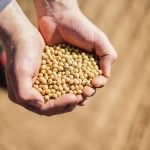Chicago | Reuters—Chicago Board of Trade soybean futures hit their highest level in more than a week on Thursday as technical buying helped the market recover from a three-month low reached on Monday, analysts said.
Corn futures retreated after rising for the previous three sessions in a rebound from contract lows set on Monday.
Both markets continued to face pressure from expectations for large U.S. autumn harvests and mostly favorable crop weather in the world’s biggest corn-producing country and second-largest soybean producer.
Read Also

U.S. grains: Soybean prices rise as China-U.S. truce assessed
Chicago soybean prices rose on Wednesday, recovering some of the previous session’s losses, as Beijing’s confirmation that it was cutting tariffs on U.S. farm goods put attention back on a trade truce between the countries.
“We’re marching to a crop, and the weather looks non-threatening,” said Don Roose, president of brokerage U.S. Commodities.
Contract highs in CBOT soyoil BOQ25 helped boost soybean futures, traders said.
Most-active soybeans Sv1 ended up 6 cents at $10.26-1/2 a bushel and hit the highest level since July 7. The market extended gains after rising on Wednesday on hopes for increased demand for U.S. supplies from Indonesia and top importer China.
U.S. soybean export sales in the week ended July 10 reached 529,600 tons for 2025-26 shipment, the U.S. Department of Agriculture said. That was above analysts’ expectations for 150,000 to 400,000 tons.
For corn, new-crop U.S. export sales of 565,900 tons were within analysts’ estimates.
CBOT corn Cv1 ended down 3 cents at $4.21 a bushel. The December contract CZ25, which represents the crop that farmers will harvest this autumn, set a low of $4.07-1/2 on Monday.
“While price weakness attracted opportunistic demand, a favourable weather outlook could well see lows tested again in the weeks ahead,” Rabobank analysts said.
U.S. President Donald Trump sparked concerns about demand for corn by saying on Wednesday that Coca-Cola agreed to use cane sugar in its U.S. beverages. Coca-Cola produced for the U.S. market is typically sweetened with corn syrup.
Around 400 million bushels of corn is used annually to make corn syrup for drinks and other food products, representing around 2.5 per cent of U.S. corn production, according to U.S. government data.
PepsiCo, meanwhile, said it was expanding use of avocado and olive oil, rather than the canola or soybean oil it uses.
In CBOT wheat Wv1, most-active futures closed down 7-3/4 cents at $5.33-1/2 per bushel after touching the lowest price since May 14.
—Additional reporting by Gus Trompiz in Paris and Peter Hobson in Canberra














